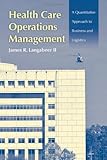Health care operations management : a quantitative approach to business and logistics / James R. Langabeer II.
Publication details: Sudbury, Mass. : Jones and Bartlett Publishers, c2008.Description: xvii, 438 p. : ill. ; 24 cmISBN:- 9780763750510
- 0763750514
- WX 157 L271h 2008
This record has many physical items (116). View all the physical items.
Includes bibliographical references and index.
Contents
PART I: Operations Management and Financial Health
Chapter 1: Healthcare Operations Management
The Role of Healthcare Operations Management
Key Functions of Healthcare OM
The Need for OM
Goals of the Operations Manager
Competitive Advantage of Operations
Factors Driving Increased Healthcare Costs
Learning from Other Industries
Principles of Management
The Scientific and Mathematical Schools of Management
Power and Decision Making in Healthcare
The Role of Technology
Trends in OM
Chapter Summary
Key Terms
Discussion Questions
Exercise Problem
References
Chapter 2: Healthcare as a Business
Hospitals are Big Business
What is a Hospital?
Teaching Hospitals
Payers and Hospital Revenues
Hospital Business Operations
Chapter Summary
Key Terms
Discussion Questions
References
Chapter 3: Healthcare Finance for the Operations Manager
From Retrospective to Prospective
Profit Margins
Income Statements
Income Statement Ratio Analysis
Balance Sheet
Working Capital
Other Financial Ratios
Financial Distress in Healthcare
Cash Flow Statement
Audited Financial Statements
Debt in Healthcare
Implications for Operations and Logistics Management
Chapter Summary
Key Terms
Discussion Questions
Exercise Problems
References
Part II: Process Engineering and Optimization
Chapter 4: Process And Quality Improvement
Strategic Choices for OM Tools and Techniques
Business Process
Flowchart Symbols
Process Maps
Process Improvement Methodology
Improving Service Quality
Key Questions to Promote Dramatic Changes
Chapter Summary
Key Terms
Discussion Questions
References
Chapter 5: Optimizing Patient and Process Flows
De-bottlenecking
Forecasting Patient Demand and Volumes
Basic Principles of Forecasting
Capacity Planning: Aligning Capacity with Demand
Minimizing Wait Times
Time and Motion Studies
Improving Flows with Tracking Systems
Bar Codes
Radio Frequency Identification
Chapter Summary
Key Terms
Discussion Questions
Exercise Problems
References
Chapter 6: Productivity and Performance Management
The Quest for Productivity
Measurement Issues
Single versus Multiple Factors
Common Hospital-Wide Productivity Metrics
Improving Productivity
Example
Principles of Productivity Management
ROI: Capital versus Labor Substitutions
Example
Staffing and Labor Scheduling Models
Productivity and Performance Scorecard
Chapter Summary
Key Terms
Discussion Questions
Exercise Problems
References
Chapter 7: Project and Change Management
Defining Projects
Power Struggles in Healthcare
Project Success
Key Stages of Project Management
Change Management
Rapid Prototyping
Risks Involved in Project Management
Departments of Management Engineering
Chapter Summary
Key Terms
Discussion Questions
Exercise Problems
References
Chapter 8: Planning for Operational Excellence
Why Plan?
The Planning Process
Analyze Operations and Environment
Generate Strategic Alternatives
Break-Even Analysis
Implement, Measure and Revise
Chapter Summary
Key Terms
Discussion Questions
Exercise Problems
References
Chapter 9: Return on Investment Models
The Politics of Capital Investment
Recommendations for Implementing Capital Investment Approach
Validating ROI at Multiple Stages
Calculating Return on Investment
Calculating Multiple Cash Flows
Other ROI Techniques
Example
Chapter Summary
Key Terms
Discussion Questions
Exercise Problems
References
Part III: Logistics and Supply Chain Management
Chapter 10: Supply Chain Management Strategy
Defining Supply Chains
Flows in Supply Chain
Components in the Chain
Spotlight on Cardinal Health
Business Processes in the Supply Chain
Supply Chain Strategy for Hospitals
Customer Demand Drives Supply Chains
Demand Chains
Principles of Supply Chain Management
Strategy and Logistics Capabilities
Efficient versus Responsive SCM Strategy
Reverse Logistics
Supply Chain Systems
Evolution of Supply Chain Technology
Recommendations for Supply Chain Management Technology
Chapter Summary
Key Terms
Discussion Questions
References
Chapter 11: Purchasing and Materials Management
Materials Management Organization
Culture of Materials Management
Revenue Generation in Materials Management
Optimizing Facility Layout and Design
Cost Minimization Models
Purchasing
Purchasing Internal Controls
Spend or Value Analysis
Group Purchasing Organizations
Trends in Hospital Purchasing
Resources for Materials Professionals
Customer Service in Materials Management
Laundry and Linen
Chapter Summary
Key Terms
Discussion Questions
References
Chapter 12: Inventory Management and Accounting
Inventory and its Role in Healthcare
The Costs of Supplies and Inventory
Differences between Supply Expense and Inventory
Impact of Timing on Expenses
Important Facts about Inventory
Criteria for Inventory
Valuation Methods
Lower of Cost or Market
Periodic versus Perpetual Systems
Accounting Entries for Supply and Inventory
Inventory Errors
Inventory Ratios
Other Inventory Calculations
Limitations of Inventory Ratios
Inventory Policies and Procedures
Inventory Planning
Inventory Audit
Inventory Management Expectations
Chapter Summary
Key Terms
Discussion Questions
Exercise Problems
References
Chapter 13: Classifying and Managing Products
Items and Attributes
Data Hierarchies
The Need for Standards
United Nations Standards Products and Services Code
Item Masters in the ERP
Enterprise Resource Planning Systems
The Item Life Cycle
Example
Product Usage Patterns
Chapter Summary
Discussion Questions
Exercise Problems
Key Terms
References
Chapter 14: Supply Chain Collaboration
Sales and Operations Planning
Objectives of Sales and Operations Planning
The Basic Sales and Operations Planning Process
Collaborative Planning Forecasting and Replenishment (CPFR)
Objectives of CPFR
CPFR Guidelines
Performance Metrics in CPFR
Chapter Summary
Key Terms
Discussion Questions
References
Chapter 15: Pharmaceutical Operations Management
The Modern Pharmacy
The Pharmaceutical Supply Chain
Managing Items using the National Drug Code
Process Workflow and Automation in the Pharmacy
Key OM Trends for Pharmacies
Impact on Pharmacy Performance
Spotlight on McKesson
Chapter Summary
Key Terms
Discussion Questions
References
Part IV: Summary
Chapter 16: The Future of Operations Management
Evolving Trends
Achieving Success in Operations Management
Chapter Summary
Discussion Questions
Key Terms
References
Appendix A: Listing of Major Teaching Hospitals
Appendix B: Answers to Selected Chapter Exercise Problems
Glossary of Terms
About the Author
Library of Congress Subject Headings for this publication:
Hospitals -- Business management.
Hospitals -- Administration.
Business logistics.
Hospital Administration -- methods.
Efficiency, Organizational.


There are no comments on this title.